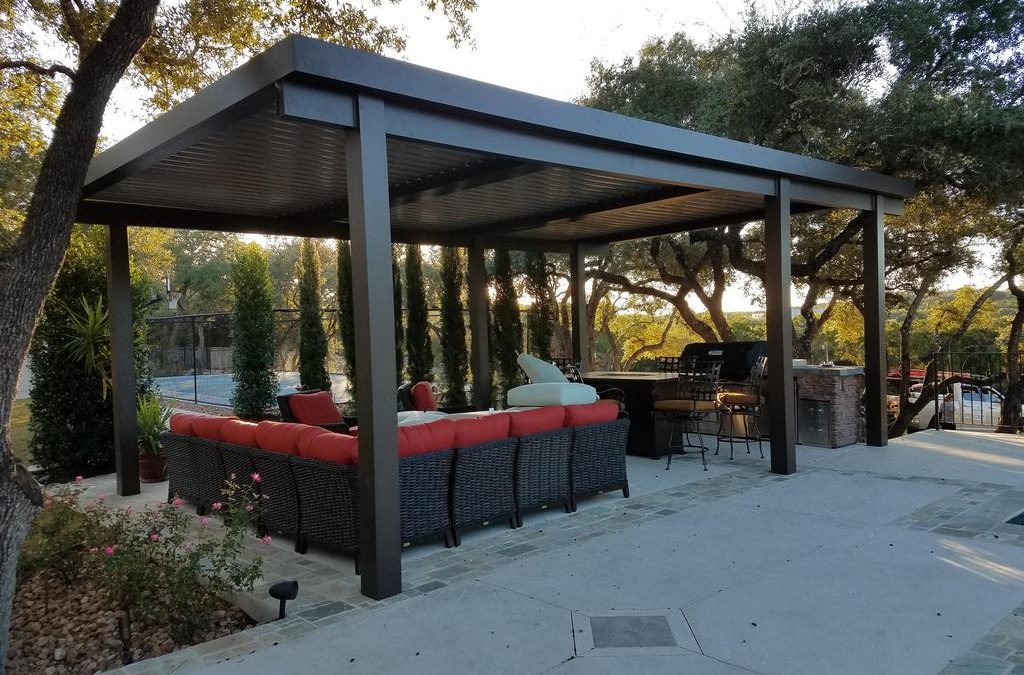Pergola Attached To House
Pergolas have become a popular addition to many homes in recent years, and for good reason. Not only do they provide a beautiful and functional outdoor living space, but they also add value to the property. In the scorching heat of Texas summers, a pergola can provide much-needed shade and a cool oasis to relax and entertain. However, choosing the right pergola for your home and needs can be a daunting task. As a builder in the fast-growing city of Comal, Texas, selecting a pergola attached to a house may be a frequent project in your repertoire. But with the abundance of options available in the market, where do you begin?
As the premier patio cover installers in the state of Texas, Bluebonnet Patio Covers has worked with countless builders, homeowners, and commercial clients to create beautiful and durable aluminum patio covers that stand the test of time. Our team has the expertise and experience to guide you in selecting the perfect pergola attached to your house. In this article, we will share our top tips and considerations to help you make an informed decision.
Understanding Pergolas: What You Need to Know
Before diving into the selection process, it is important to have a basic understanding of what a pergola is and what it can offer. At its core, a pergola is a structure consisting of columns supporting a slatted roof. Unlike a traditional patio cover, a pergola usually has open sides, offering an airy and open feel to the space. The roof can be made of materials such as wood, vinyl, or aluminum, depending on personal preference and budget.
One of the main benefits of a pergola is its ability to provide partial shade. By strategically placing the slats, homeowners can determine the amount of shade they desire while still allowing for natural light and airflow. This makes pergolas an ideal choice for outdoor dining and entertaining spaces, as well as relaxation areas.
Key Considerations When Selecting a Pergola Attached to Your House
Now that we have a basic understanding of pergolas, let’s dive into the key considerations to keep in mind when selecting one for your house.
1. Materials
The material you choose for your pergola will not only determine its aesthetic appeal but also its durability and maintenance needs. Popular options include wood, vinyl, and aluminum. Wood offers a natural and rustic look, but it requires regular staining and sealing to withstand the harsh Texas climate. Vinyl is low maintenance and comes in a variety of colors, but it may not offer the same structural integrity as wood or aluminum. Aluminum, on the other hand, is durable, lightweight, and comes in a range of styles and colors to suit any design aesthetic.
2. Size and Placement
The size and placement of your pergola will depend on the intended use and the available space. Pergolas can be attached to the house or freestanding in the yard. When attached to the house, they offer a seamless transition between indoor and outdoor living spaces. However, they may be limited in size due to the existing structure and may require additional support columns. Freestanding pergolas can be larger and provide more options for placement in the yard, but they may not offer the same convenience and protection from the elements as attached ones.
3. Roof Style
The style of the pergola’s roof can significantly impact its functionality and aesthetic appeal. Popular options include flat, gable, and pitched roofs. Flat roofs allow for easy customization and flexibility with the placement of slats, but they do not provide as much protection from the sun and rain. Gable and pitched roofs, on the other hand, offer more shade and protection but may require additional support and maintenance.
4. Budget
Like any home improvement project, setting a budget for your pergola is essential. The materials, size, and design you choose will ultimately determine the cost. Wood may be less expensive than aluminum, but the maintenance costs may add up over time. On the other hand, investing in a high-quality aluminum pergola may cost more upfront but will require minimal maintenance in the long run.
5. Local Regulations
Before beginning any construction, it is crucial to check with your local building department for any regulations or permits required for building a pergola attached to your house. Some areas may have specific setback requirements, height limitations, or design guidelines that need to be followed. It is always better to be aware of these regulations beforehand to avoid any delays or issues during the construction process.
Key point
Selecting the right pergola attached to your house may seem overwhelming, but with the right information and guidance, it can be a fun and fulfilling experience. As a builder in the growing city of Comal, Texas, adding a pergola is an excellent way to enhance the value and charm of any property. By considering essential factors such as materials, size, budget, and local regulations, you can make an informed decision that will result in a beautiful and functional addition to any home.
Topics:


Recent Comments